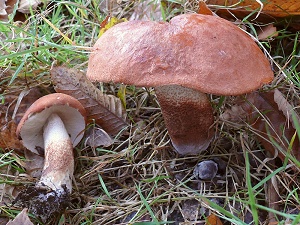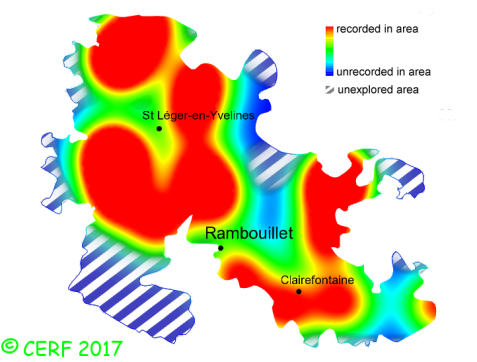| Leccinum quercinum (Pilát) E.E. Green & Watling |
|
|
|
|
|
|
The cap is of a uniform matt orange-brown to red-brown or chestnut brown (brownish shades dominate, and this increases with time), fleshy, firm, globular at first, then hemispherical, remaining convex until the end. The cap surface is felty then smooth. The cap margin is exceeding, and covering pores. The stem is full, long and firm, with a rough surface because of the scales covering it. It is cylinder-shaped, but tapering at the top and slightly larger at the base. This stem base it sometimes stained with blue-green, more so when pressed. The stem's background colour is white, the scales covering it being brown, eventually black with age and darkening when touched.. The flesh is thick, firm, the stem being fibrous. It is white but becomes vinaceous-pink in the cap when in contact with air, and rather grey-black in the stem (its base however becoming slightly green-blue when exposed to air); its taste is faint and mild; the odour is weak and pleasant; The tubes are whitish to ochre, often darker with age (brown). The pores are small, round, whitish to ochre, becoming vinaceous red when pressed. The spore print is tobacco brown. It grows in broad-leaved woods, essentially with oak, but also beech, chestnut, lime-trees, in principle never with birch, poplar or conifers. The fruiting period takes place from July to November.
Chemical tests : no reaction to iodine or ammonia. Distinctive features : orange to orange-brown cap; white to ochre pores; tough stem, covered with brownish scales turning blackish when mature; white flesh turning pink in cap, grey in stem and blue at stem base when exposed to air; with oak, beech, linden, chestnut trees Leccinum quercinum is frequent and widely present in the forest of Rambouillet, and is infrequent, more generally speaking . | ||
|
page updated on 14/01/18

